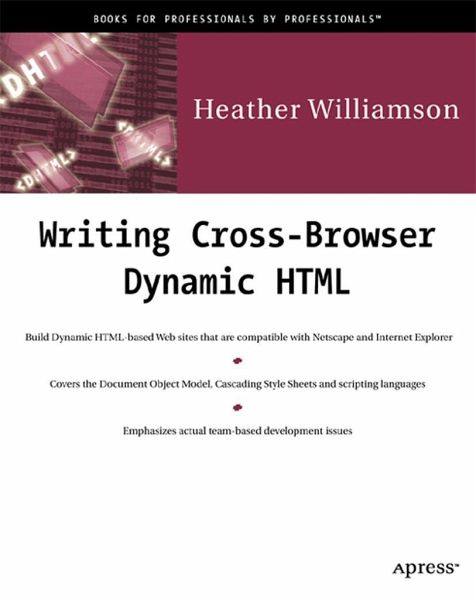Nicht lieferbar

Writing Cross-Browser Dynamic HTML
Versandkostenfrei!
Nicht lieferbar
Divided into three sections, the book first treats in detail the technologies, concepts, and standards needed to use dynamic HTML for users running all the popular late model browsers: version 4.0 and higher. This section also discusses the implementation and development of HTML, cascading style sheets, competing models of the DOM, and the JavaScript/JScript/ECMAScript techniques needed to control it. The second section teaches Web designers how to use DHTML to develop a dynamic site, focusing on implementation issues related to maintaining cross-platform compatibility. A tutorial in this section shows readers how to create a completely interactive Web site, ready to post on the Web. The third and final section provides alternate ways to use functions and features similar to those used in the second section.
Both Netscape and Microsoft have created their own versions of Dynamic HTML (DHTML). Incompatibilities between their browsers make it very difficult for web designers to use DHTML to add advanced user interface features to their sites. This is the first book that answers the question webmasters are asking more and more frequently: How can DHTML be used effectively, given the issue of incompatible browsers among users? Writing Cross-Browser Dynamic HTML focuses on answering this critical question without getting sidetracked into general HTML or XML issues. The result is a book that clearly and concisely addresses programmers' needs without overwhelming them with a cumbersome volume that tries to answer every possible question about DHTML.
Author Heather Williamson begins by introducing the fundamental concepts upon which DHTML programming is based: the Document Object Model, Cascading Style Sheets, and scripting languages. In each case, she cites the differences betweenthe Netscape and Microsoft implementations of these features. You'll learn which features can be used safely, which must be avoided, and how to use scripting languages to overcome differences between DHTML implementations.
Williamson then moves into an in-depth discussion of how to use the knowledge of DHTML differences in real-world applicationsspecifically, as applied to a highly interactive professional website. She finishes the book by going beyond the purely technical issues to discuss how compatibility must be incorporated into the development process, especially when teams of developers are involved.
Author Heather Williamson begins by introducing the fundamental concepts upon which DHTML programming is based: the Document Object Model, Cascading Style Sheets, and scripting languages. In each case, she cites the differences betweenthe Netscape and Microsoft implementations of these features. You'll learn which features can be used safely, which must be avoided, and how to use scripting languages to overcome differences between DHTML implementations.
Williamson then moves into an in-depth discussion of how to use the knowledge of DHTML differences in real-world applicationsspecifically, as applied to a highly interactive professional website. She finishes the book by going beyond the purely technical issues to discuss how compatibility must be incorporated into the development process, especially when teams of developers are involved.



